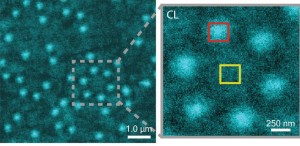
Soft matter encompasses a broad swath of materials, including liquids, polymers, gels, foam and—most importantly—biomolecules. At the heart of soft materials, governing their overall properties and capabilities, are the interactions of nano-sized components. Observing the dynamics behind these interactions is critical to understanding key biological processes, such as protein crystallization and metabolism, and could help accelerate the development of important new technologies, such as artificial photosynthesis or high-efficiency photovoltaic cells. Observing these dynamics at sufficient resolution has been a major challenge, but this challenge is now being met with a new non-invasive nanoscale imaging technique that goes by the acronym of CLAIRE.
CLAIRE stands for “cathodoluminescence activated imaging by resonant energy transfer” and combines elements of optical and scanning microscopy into a single imaging platform. The system utilizes an ultrathin scintillating film that is placed between the electron beam and sample. When the film is excited by the electron beam, it transfers energy and causes the sample to radiate. In this way, an image can be formed that is not restricted by the optical diffraction limit.
Invented by users of the Molecular Foundry, CLAIRE extends the incredible resolution of electron microscopy to the dynamic imaging of soft matter. The research team recently demonstrated CLAIRE’s imaging capabilities by applying the technique to aluminum nanostructures and polymer films that could not have been directly imaged with electron microscopy. They obtained optical images of aluminum nanostructures with 46 nm resolution, then validated the non-invasiveness of CLAIRE by imaging a conjugated polymer film. The high resolution, speed and non-invasiveness could transform the way key biomolecular interactions are studied.

